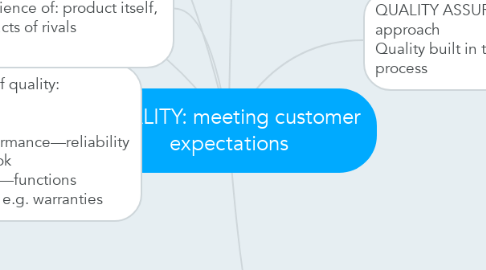QUALITY: meeting customer expectations
by r g sewell

1. Meaning of quality: Basic function Features Product performance—reliability Aesthetics/look Added extras—functions Added extras e.g. warranties
2. Expectations come from: Branding & marketing Experience of: product itself, products of rivals Price
3. Advantages of meeting customer expectations ↑ competitiveness ↑ reputation USP ↓ Reduce unit cost Allow price flexibility
4. SERVICES & QUALITY Achieving quality in service industries requires: Friendly staff Knowledgeable staff Speed of service Comfortable environment physical or virtual
5. Quality Control -Traditional approach Process of checking/inspecting for quality.
5.1. Stages of quality control: Pre-production—check raw materials & components During production - check part-made products Post-production—check the finished product
5.2. Ads Defects are found and rectified
5.3. Dis-ads Reduced responsibility Resentment Cost of checking Limited to samples
6. QUALITY ASSURANCE modern approach Quality built in to the production process
6.1. Advantages ↑ staff morale ↑ consistent quality—USP ↓wastage ↓ cost of reworking defective products
6.2. Dis-ads ↑ Training costs Slower production Needs committed workers
7. QUALITY ASSURANCE APPROACHES
7.1. Total Quality Management ‘Get it right first time’ - 100% customer satisfaction —Zero defects Internal and External customers Total: involves all employees and suppliers Quality: concern to meet internal and external customer expectations. Management: all employees are pro-active and systematic in delivering a quality product first time and seek continuous improvement Quality chains: focus upon quality throughout the supply chain.
7.2. Kaizen and Continuous Improvement 100% perfection by continuously attempting to improve quality and efficiency/reduce waste in the production process Advantages (i) improved quality (ii) improved efficiency – lower min. av. cost (iii)gradual change reduces resistance to change
7.3. Quality Circles - small worker groups who meet to discuss ways of improving productivity and quality. Advantages 1) involve workers in problem solving/decision making 2) motivation; 3) make good use of those closest to production/systems


